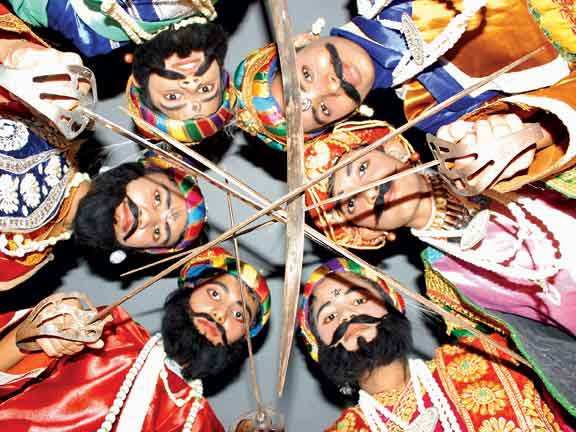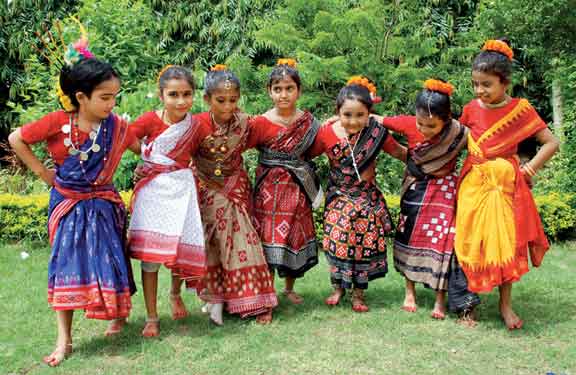Ananda Shankar Jayant
India 2010. A pulsating energy of the can-do spirit, a synergy of ancient India walking hand in hand with a young India – ready to take on the world – nay – ready to lead the world!
An India – where competition is the new mantra, and excellence its hand maiden, standing on the cusp of a dazzling new era of growth and abundance in every field of human endeavor.
An era quite propitious for art and artistes – every dawn brings in a fresh new perspective, a rewriting of content, of redrawing of structures and a rewiring of codes! An exhilarating freedom to scale personal levels of creativity and expression. A new and free marketplace that is open to new explorations and ideas. Yet, it is this very market place of liberalization and globalization that has marginalized art in the lives of children.

Do you remember the time when you came home really tired after an afternoon of practicing for a song, play or group dance for the school annual day, and yet had more energy than on days when you had a battery of tests?
Do you remember the fun that you had as a group, trying to get your rhythm, step, coordination and team work together?
Do you remember the animated discussions that you had with your team performers on what to wear and how to put it together?
Do you remember the excitement on the morning of the performance, when you could not sleep the previous night, and were up really early, and couldn’t wait to get into your make up and gear and go on stage?
Do you remember the nervousness and clammy hands before going on stage and how after a command performance, you received loud applause and praise, and all the extra love showered from family and friends?
So what’s happened today? Art has lost its position of pre-eminence in the teaching and learning trajectory of schools. Today, there is little or no place for art in the lives of schools and children, as schools churn out students fit and ready only to take the myriad common entrance tests.
For a moment, let me play devil’s advocate!
Why should we inculcate an appreciation of the arts?
Some of the arguments most often put forth against this are:
- It does not lead to a career, at least not a well paying one
- Time spent on art can be utilized better, in preparing for the competitive exams, and the various JEEs so that children can start life with a great job
- I, as a parent anyway introduce my child to what I think my child is interested in, with professional teachers outside, so why should the school waste precious time on art. Instead they can focus on mainstream curricula
- The school has a very tight budget and hence we can do without an art teacher, and instead use that money for something more ‘useful’ and practical
- We don’t need a specialist art teacher, anyone can teach art, etc., etc.
Is this the subconscious sub-text of parents, schools and teachers today?
Now, let us ask ourselves some hard questions:
Why do we need art at all in the first place?
- Well, it has been proven that art enables and enhances creativity, understanding, nurtures inventiveness and inquisitiveness in the child, develops self-esteem, self-discipline, cooperation, and self- motivation, and trains the child in creative problem solving, and improves communication skills.
- Exposure to art helps students in understanding mainstream subjects like math and science, by helping the child build mnemonics for memory and understanding in a very personal and creative way.
- Participation in art activities help children in understanding human experience, adapting and respecting others’ ways of working and thinking. Art training helps the student in expansive thought and search for creative solutions, strengthens interpretative skills, promotes a sense of understanding, design and nurtures personality, people skills, observation skills, and kindles the inquisitive spirit.
Okay so we all know that!
Now let us explore how school authorities position arts classes
- Is it the first class that is being dispensed with?
- Are art teachers mostly the lowest paid?
- What is the quality and training of the arts teacher?
- What is the premium put on learning any of the arts by other teachers?
- What is the premium, if any, that the school, teachers and parents place on learning art?
- Are art classes only geared towards presenting the school annual programme, or is it towards learning?
- If any of the arts are taught, how much of it is only popular and film?
- In the race to a 100% score and great results at the Boards, is the school compromising on providing holistic education?
Very often, much of the above is true.
So how can we change it?
- By having a little rethink on what is the take away from teaching and learning any of the arts. How about conveying to parents and students the importance of exposure to art, and the required rounding and grounding that learning any art brings to the child.
- Bringing about an understanding among all stakeholders: teachers, parents and children, that art enriches the trainer and the trained.
- By ensuring that art classes are not interpreted as girlie classes. In a co educational school, this is a real hurdle. Centuries of differential upbringing between boys and girls, have made arts the preserve of girls.
- Make learning of any one art form compulsory for the students. Taking art education beyond the arts classroom and integrating it with other subjects.
- Offering a special prize/grade for students interpreting their mainstream subjects using art, etc.
So, where do you begin?
Art activities inside the classroom
After a new lesson, say on history, has been taught, students can present, the historical event as an impromptu play, with dialogues devised by the group itself. This way, they will have to pay attention too!
One group could get together and make costumes for the play.
One group could make a project presentation of it.
Another group could paint the event.
One group could find another similar story in history, from the same period.
One group could figure out the arts and crafts of the period, and maybe even fashion a few based on that knowledge.
One group could even find similarities of the historical narrative in maybe a recent film.
A debate could be organized on any one newly learnt lesson.
For example: A lesson on Akbar, should open the child’s mind to Fatehpur Sikri, how red sand stone is used there, the movie Jodha Akbar, an understanding of Rajput traditions, the unity between Hindus and Muslims then, Akbar’s Din-I ilahi, etc. Of course, all this will be the learning that the child will bring to the classroom through different art projects.
Again for a subject say like science, where projects are part of the curriculum, how about, going beyond the scientific principles and introducing the child to the inventor, his life story, the time and country he lived in, the dress of the era, the language he spoke, etc., and then have the student do the science project with the look and feel of the relevant period.
For example: Newton’s law of gravity. How about a group exploring Newton’s life and presenting that along with the laws of gravity for this project?
How about teaching arithmetic, by bringing a local drummer or musician, to share how he uses math in his drumming or music?

Art activities outside the classroom
How about asking one group to cull all the news about various programmes in the city and put it up on a notice board, under separate sub headings of music, dance, painting, theatre, etc., maybe once a week?
The next group can then choose to read something about any one sub group, say, dance. If the event notice says a Bharatanatyam recital, then that group can talk or write a very small project on this art form. Another could do this on music, etc.
Another activity could be to delve deeper and do a small write up on the performing artistes.
One group could go to the event, and submit a review, of what they liked or didn’t like or didn’t understand (usually, organizations will be happy to allow children free, and the school could also tie up with a nearby organization, for this).
One group could draw/paint the event.
A group discussion about the event can be arranged. The school could invite the artiste for a small talk, when students can ask questions.
Field trips
Schools can organize short field trips to the homes and studios of the nearest painter, sculptor, musician or dancer, and observe the process of how their art evolves. After which a report or presentation can be made not only about the art and artist, but also, about the extraneous stuff, like the economics of maybe the cost of a canvas, or sculpting clay, cost of brushes, the names and numbers for some of the brushes used by the artist, or maybe details about the warm up exercises that a dancer undertakes before practice, or how an artiste tunes the tanpura, and what is the terminology for the various srutis, etc.
Street plays
Ask the students to do impromptu street plays, within the school premises on any burning issue or an important event. Example, IPL, or Ganesh Chaturthi, Id, Commonwealth games, etc.
Try and encourage the students not to download from the Net, or to use too much of film music. Let them create verse and set it to music, write dialogues, make costumes from stuff available at home. This way their imagination and creative processes will be triggered, and they will stretch themselves.
These are only a few ideas of how class teachers can integrate the arts and daily curricula in the learning process of their wards.
Remember, teaching children about the arts is not just about showing them how to recognize a great painting or artiste, it’s about preparing young minds for a future of precious, priceless and invaluable experiences – art related or otherwise… because art engenders creativity and, students are able to think for themselves and make decisions based on what they want to do.
- Art teaches the invaluable skill of interpretation.
- Art revolves around discussion.
- The basic premise of art is design, which is an inestimable necessity in all walks of life.
- It is proven that a child introduced to the arts, also does very well in academics.
- Art can only happen with complete focus, and students learn this elusive quality without much ado, and learn to use it in all areas of their lives.
- Good art can only happen with self-discipline and results in great self-esteem.
- Art teaches problem solving skills and cooperation with others.
- Art is its own motivation, and enriches you.
- Art teaches sensitivity and teaches a child to be considerate.
- Art triggers curiosity, which is the cornerstone of good learning.
- Art makes you happy. The very act of creation is its own reward, and a bunch of happy, balanced and integrated students eager to learn and grow, is every teacher’s dream.
- Whatever we know of human history is through art.
- Art brings imagination to life and life to imagination.
- Art becomes that personal wellspring of strength that one can dip into for support and succour, when life challenges you.
The author is a distinguished classical dancer, teacher and choreographer. She is also a senior officer in the Indian Railways and holds a Doctorate in Tourism and Culture. She received the Padmashri in 2007. She can be reached at anandasj@rediffmail.com.
